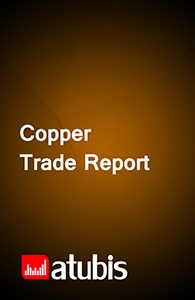Saudi Arabia’s Copper Scrap and Waste Market Outlook Report
475,000 ₺
- EUR: 9,778€
Copper scrap is one of the supply sources in the copper industry. It accounts for a third of total copper consumption in Saudi Arabia. Scrap is used in either of two ways: it is cast and refined into cathodes or unwrought products, or directly used in the production of copper and alloy semis. In the latter case, production costs are significantly reduced. Thus, copper scrap is mostly cast into unwrought products and sold to upstream buyers (to be converted into cathode) and downstream semis producers. It should be noted that semis producers with fire refining furnaces directly use scrap rather than secondary unwrought copper to produce semis.
Product Description
With a GDP of over $793 billion in 2019, Saudi Arabia was the largest economy in the region that year. The country’s economy, the second richest country in terms of natural resources, is heavily dependent on oil, its main natural resource. But since the introduction of the 2030 Vision in 2016, the country has determined to minimize oil reliance; it has made significant investments in downstream oil sectors, especially petrochemicals. Thus, with the development of energy-intensive industries like petrochemicals and the development and optimization of infrastructure, the wire and cable industry has grown significantly. As a result, the copper industry has been established in the country. However, with the absence of rich copper resources, developments have been limited. Copper production has mostly been justified with gold as a by-product.
Market drivers of Saudi Arabia’s copper scrap
Construction growth and the development of power infrastructure will boost demand for copper and alloy RBS, which are major scrap consumers. Moreover, scrap is a secondary source following mine production in global markets. It should be noted that global demand for copper is outpacing mine supply, widening the gap between supply and demand, which can be filled with scrap. Thus, many are forecasting stronger global demand for copper scrap.
With the growing importance of preserving mine resources and the changing attitude towards environmental conservation, secondary sources will gain momentum. As a result, recycling will become increasingly important, pushing collection rates higher and supporting demand for scrap. Natural resources and environmental protection are in the spotlight in Saudi Arabia; this will boost the effectiveness of the environmental factor.
Currently, due to the high copper prices, the consumption of copper in some applications has been replaced with other metals such as aluminum and zamak. With forecasts of higher copper prices in the future, the trend is expected to continue; this will dampen demand growth for copper and scrap.
Overview of Saudi Arabia’s copper scrap market
Unwrought producers in Saudi Arabia, especially producers of billets and ingots, are the major consumers of copper scrap. As unwrought output increased over the recent years, scrap demand surged; as a result, the growth of scrap exports slowed. But as more goods are scrapped over the coming years with the economic recovery, supply is expected to increase as collection rates rise. On the other hand, scrap demand will also increase along with the growing demand for copper semis (especially RBS). Thus, the increased domestic supply will mostly be consumed domestically, with a limited effect on trade balance.
Breakdown of Saudi Arabia’s copper scrap market
Saudi Arabia’s copper scrap supply is broken down into old and new scrap. Demand is also analyzed based on three factors. In the first breakdown, copper scrap is categorized according to composition: non-alloy, brass, and alloy (excluding brass); past and future trends for each category have been analyzed. The second factor breaks down the market into cathode scrap, bare bright scrap, telecom scrap, heavy scrap, winding wire scrap, and radiator tube scrap. Finally, the third factor makes a distinction based on the type of consumers, including producers of cathode (to produce anode), unwrought products, wire rod, tubes, and casting parts. Unwrought producers hold the largest share in scrap consumption.
Key players in Saudi Arabia’s copper scrap market
- Saudi Electric Industries Co.
- Saudi Mechanical Industries Company (SMI)
- Aboura Metals
- Arab Academy Inc.
- Services Specialist Trading Establishment
- Anwaar Group
- Mahaver Trading Company
Additional Information
| Industry | Copper Scrap |
|---|---|
| Region | Saudi Arabia |
| Report Type | Industry Report |
Specifications
| Report Attribute | Details |
| The base year for estimation | 2021 |
| Historical data | 2011-2020 |
| Forecast period | 2021-2026 |
| Quantitative units | Value in USD and Volume in Tonne |
| Report coverage | Market Overview, Dynamics, Market Outlook, Risks to Forecast, Consumer Market, Industry Overview, Market Landscape, Competitive Landscape, Market Attractiveness, External Macro Environment Analysis |
| Segments covered | Composition, Type, Application |
| Pricing and purchase options | Please explore our purchase options to meet your exact research needs. |
Reasons to Buy
- Recognize the geographical distribution of import demand
- Identify the current and future key players of the trading market
- Achieve a better insight on potential target markets
- Understand the behavior of major suppliers/customers either globally or regionally
- Identify competitors as a feed for market analysis
Table of Content
- Executive summary
- Introduction
- Objective
- Market under study
- Supply Market
- Specifications
- Consumption structure
- Applications
- Physical properties
- Subjects discussed
- Geographical scope under study
- Study timeframe
- Study currency
- Potential audience
- Market dynamics
- Market drivers
- Restraints
- Opportunities
- Challenges
- Market overview
- Market size
- Supply
- Supply trends
- Efficiency rates
- Consumption
- Consumption trend
- Consumption Share of domestic product
- Trade
- Exports
- Imports
- Trade balance
- Market balance
- Market breakdown by application
- Inventory
- Supplier inventory
- Consumers inventory
- Market outlook
- Market factors
- Costs and prices
- Competition
- The government
- Other factors
- Future scenarios
- Risks to forecast
- Market factors
- Consumer markets
- Direct consumer markets
- Capacity of Consumer Market
- Consumer Market Operation
- Trade of Consumer Market Products
- Consumer Market Factors
- Forecast of Consumer Market
- Direct consumer markets
- Export potentials
- Destinations
- Trade and insurance costs
- Import market suppliers
- Producers potential share
- Destinations
- Available EOL Scrap
- Market landscape
- Domestic sales markets
- Pricing in the domestic market
- Potential domestic demand
- Trade agreements for imports
- Foreign suppliers
- Foreign sales market
- Prices
- Potential markets overview
- Trade agreements for exports
- Foreign customers
- Domestic sales markets
- Competitive landscape
- Consumers
- Company profile
- Revenue structure
- Gross profit margins
- Capacity, Supply and sales
- Consumers
- Market attractiveness
- Industry rivalry
- Threat of new entrants
- Threat of substitutes
- Bargaining power of buyers
- Bargaining power of suppliers
- Conclusion of Porter analysis
- PESTEL analysis
- Political factors
- Economic factors
- Social factors
- Technology factors
- Environmental factors
- Legal factors
- SWOT analysis
- Short-term strategies
- Long-term strategies
List of Figures
- Supply and consumption; 2011-2021
- Market share of product applications; 2021
- Market surplus; 2021-2026
- Process flowchart
- Market size; 2011-2026
- Amount of supply; 2011-2026
- Efficiency rate; 2011-2026
- Amount of consumption; 2011-2026
- Consumption share of domestic product; 2011-2026
- Exports of product; 2011-2021
- Imports of product; 2011-2021
- Historical trade balance; 2011-2021
- Future Market balance; 2021-2026
- Market consumption breakdown by application; 2011-2026
- Inventories of suppliers; 2011-2021
- Consumers’ inventory of product; 2011-2021
- Production forecast, according to supply and sales analysis; 2021-2026
- Market surplus; 2021-2026
- The share of end-user industries in the consumption; 2011 and 2021
- Changes in the end-consumption of products; 2021 vs 2026
- Capacity distribution structure of direct consumers; 2021
- Existing capacities of direct consumers in each province; 2021
- Suppliers of the export potential destination; 2021
- Historical exports to the export potential destination and future potential; 2016-2026
- Sales channels
- Realized price of the product in the market; 2011-2026
- Potential demand of each province; 2021
- The main foreign suppliers to the market; 2011-2021
- FOB price vs domestic market; 2011-2026
- Map of global major importers > 20,000t; 2021
- Major foreign customers; 2011-2021
- Revenue structure of the consumers; FY2021
- Sales income and gross profit margin of the consumers; FY2011-2021
- Supply and sales of the consumers; FY2011-2021
- SWOT matrix
- Strategies positioning


